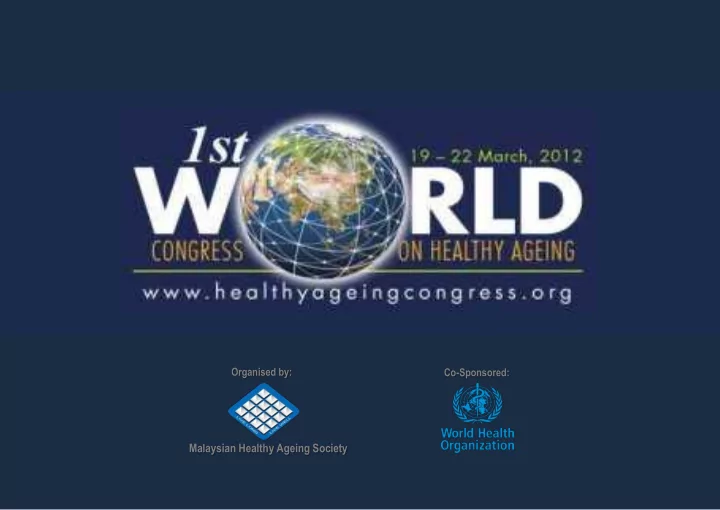

Organised by: Co-Sponsored: Malaysian Healthy Ageing Society
The economic implications of ageing 1st World Congress on Healthy Ageing 2012 Kuala Lumpur, Malaysia Eduardo Klien HelpAge International
World Population Aging Under Age 5 and Over Age 65
Population Aging Under Age 5 and Over Age 65
Population Ageing Under Age 5 and Over Age 65
Healthy ageing is the result of a combination of interacting factors: • Absence of poverty • Prevention and knowledge • Lifestyles • Community enabling environments • Health care systems
Economic implications of ageing in three key policy areas 1. Income security in old age 2. Access to health 3. Care
Economic “burden” Will there be a rising “burden” of dependency in the region? Yes, but: • Changes in dependency rations will in some cases create opportunity: demographic dividend • In Asia roughly 4 out of 5 older people do NOT have any form of pensions • Large proportion of older people are part of the workforce
Dependency ratio in ASEAN 50% 45% 43% 41% 40% 37% 36% 35% 30% 26% 0-14 25% 23% 60+ 20% total 18% 15% 10% 10% 6% 5% 0% 1990 2015 2050 Source : World Population Prospects: The 2008 Revision Population Database, United Nations Population Division http://esa.un.org/unpp/index.asp?panel=2) z Compiled by HelpAge
Income security in old age Two areas: • Pensions • Livelihoods
Retirement and pension a) Contributory pension In Developing Asia only 21% receive contributory pension. Issues: – - Expansion to informal sectors – - Age of entry (retirement age) b) Non-contributory pension (social pension) Different ways of targeting (Universal, means tested
Older people at work • In Vietnam by age 70 58% of men and 43% of women remain economically active , still working 35 hours and 32 hours a week respectively. • A research in India shows that 1 out of three men over the age of 80 are still working ( I. Rajan ) • Unaccounted work of grandparents as primary carers of children. In China over 56 million children are partially or totally cared by Grandparents) China Labour Bulletin
2. Healthcare for older people
Life Cycle and Independent Living Autonomy Healthy living and healthy ageing Age Infancy Youth Adult Old Very Old
Life expectancy after 60 (years) 30.0 Unhealthy Healthy 25.0 5.4 20.0 5.5 6.7 15.0 6.4 10.0 19.6 13.9 11.9 10.6 5.0 0.0 Japan China India ASEAN Source: UN DESA (Department of Economic and Social Affairs, Population Division) Population Ageing and development Wallchart 2009. Downloaded on 18th May 2010 from http://www.un.org/esa/population/publications/ageing/ageing2009chart.xls Compiled by HelpAge
Challenges on Health systems • Largely due to ageing, there is now prevalence of non-communicable diseases. Health systems not prepared • Non-communicable diseases (e.g. stroke, cardiovascular disease and cancers) significantly affect quality of life • Mental illnesses may increase in the Asia/Pacific region from 13.7 million people in 2005 to 64.6 million by 2050
Cost of NCDs • 75% of the deaths in the region are attributable to NCD compared to 14% of deaths from communicable diseases. • 26,500 people die from NCDs daily in the WPR – 7 out of every 10 deaths in the Region are due to NCDs • Close to ½ of deaths occur in people under 70 years of age – productive years • NCDs represent 92% of the burden of disease (DALYs) in high income countries and 63% in middle and low income countries. • An additional 2% reduction every year over the next years would mean 10 million lives saved in the Western Pacific • A World Bank study (2000) found the cost of treating NCD was between 39% and 58% of total health care expenditure in 3 Pacific countries • Lost productivity due to NCDs between 2005 and 2015 will cost China over US$ 550 billion
2. Care and support
Continuum of Care Cost of Nursing Home Care Home for he Aged Short Stay Day Care Paid Home Care Difficulties of ADL & Volunteer IADL of OP Home Care Community based care Institutional care Source: HelpAge Korea
Older People living alone (%) 16 14 12 10 8 6.0 6.0 4 2.0 2.0 0 Japan China India Fiji Bangladesh ASEAN Source: UN, Living Arrangements of OP around the world, 2005 Compiled by HelpAge
Ageing in place • Shanghai is proposing a 90-7-3 policy • Some countries — e.g. Singapore and Hong Kong — with quasi-public housing provision, aim to enable families to live with/near older relatives - allocation of housing units (apartments) nearby for children and older parents - more rapid allocation of public housing when older relatives are included.
What can healthy ageing do for general economic growth? • Effective reduction of dependency ratios • Improved general productivity • Delay long-term care needs • Have more “harmonious” societies
Conclusions • We are in the midst of a huge demographic shift that is compressed in time and comprehensive in scope • There is a window of opportunity to prepare for these new conditions and this requires decisive social and economic policies • Three priority areas are: income security in old age, new paradigms on health and adaptive policies on care
Thank you
Recommend
More recommend